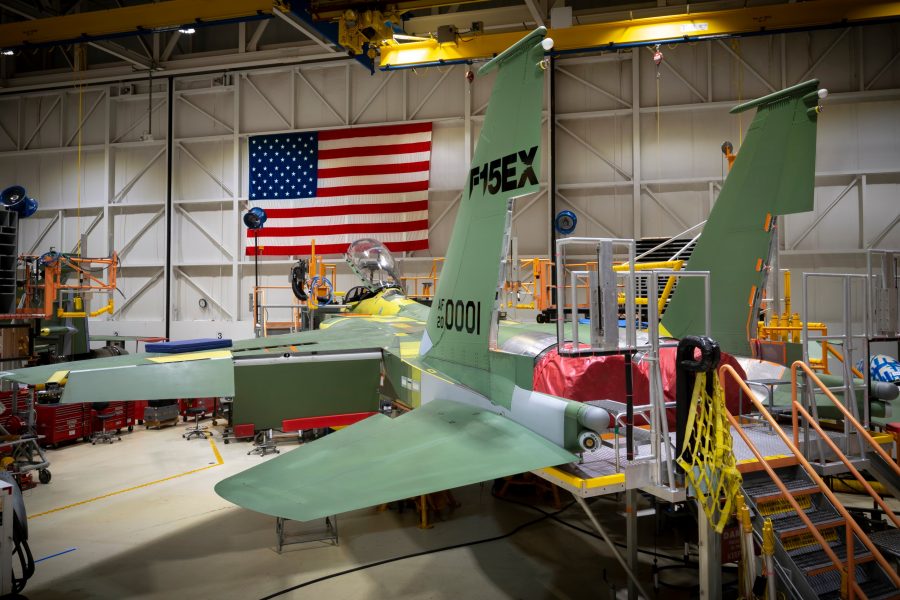The Air Force made the first payment on what could be a $22.89 billion acquisition of F-15EX fighters, the service announced July 13.
The $1.2 billion contract to Boeing covers the first lot of eight aircraft, which are to be used as test machines, and they will be deployed at Eglin Air Force Base, Fla. The first two aircraft will be delivered in the second quarter of fiscal year 2021, and the remaining six in fiscal 2023. “The strategic basing process is in work to determine the fielding locations” for subsequent lots, the Air Force said in a statement for the press.
The July 13 contract provides for the “design, development, integration, manufacturing, test, verification, certification, delivery, sustainment, and modification of F-15EX aircraft,” including spares and support gear, technical and training manuals, and support, USAF said. It is a cost-plus-fixed-fee, cost-plus incentive fee contract.
The Air Force also awarded a $101.4 million contract to GE for the first lot of 19 F-15EX engines—the GE-F110-129—on June 30. The engines will power eight aircraft and there will be three spares.
The F-15EX replaces the oldest F-15C/Ds in the inventory. Eight were approved in the fiscal 2020 budget and 12 were requested for fiscal 2021. Over the five-year Future Years Defense Program, the Air Force expects to buy 76 of the aircraft, toward a possible ultimate buy of 144 airplanes.
It’s not clear how many aircraft the $23 billion IDIQ contract will buy. An Air Force spokesman said the dollar figure is an “upper limit that provides a 10-year ordering period with a 15-year period of performance.” Boeing has said the aircraft would have a flyaway unit cost of around $80 million a copy. If the Air Force means to procure 144 aircraft at $23 billion, the cost per jet including development, facilities, test, and upgrades would be more than $159 million per airplane, not including engines.
Gen. James M. Holmes, head of Air Combat Command, said the F-15EX is “the most affordable and immediate way to refresh the capacity and update the capabilities provided by our aging F-15C/D fleets.” The first one will be “ready to fight as soon as it comes off the line.”
The Air Force did not request the F-15EX, but it was inserted into the service’s fiscal 2020 budget at the behest of the Pentagon’s Cost Assessment and Program Evaluation shop, with the approval of then-Defense Secretary Jim Mattis. Air Force Chief of Staff Gen. David L. Goldfein said at the time the Air Force’s top fighter priority is still the F-35, but the F-15EX can provide near-term capacity the F-35 could not quickly backfill as the 1980s-vintage F-15C/D fleet ages out in the coming five years. Because it can make use of existing hangars, ground equipment, and other support systems, the F-15EX will be able to transition from production to flightline “in a matter of months, not years,” Holmes said.
Critics of the buy say even a souped-up F-15 is not a stealthy, fifth-generation aircraft, and the Air Force is buying a combat airplane that will not be able to survive in highly contested airspace within 10 years, although it will have a life expectancy into the 2050s. “It is perhaps the most un-cost-effective expenditure ever made by DOD,” said retired Lt. Gen. David A. Deptula, head of AFA’s Mitchell Institute for Aerospace Studies.
Holmes has said that in 15 years or so the F-15 would still be useful for homeland defense missions or in areas where air defenses are not as severe.
The aircraft differs from the C/D model in that it is a fly-by-wire, digital aircraft; has a powerful new processor; additional wing hardpoints; a new electronic warfare system; an updated “glass cockpit;” and the latest software for the Eagle. It is based on the F-15QA, which Boeing is building for Qatar. The EX also has an open mission systems architecture.
“Continually upgrading systems, and how they share data across a Joint Force, is critical for defeating advanced threats,” said Will Roper, Air Force service acquisition chief. The F-15EX “is designed to evolve from Day One,” he said.
“The F-15EX is the most advanced version of the F-15 ever built, due in large part to its digital backbone,” Boeing F-15EX program manager Lori Schneider said in a press statement. She described it as having “unmatched range, price, and best-in-class payload capacity.”
Boeing said the EX can launch hypersonic weapons up to 22 feet long and weighing up to 7,000 pounds. It also described the program as a “pathfinder for the Department of Defense’s DevSecOps initiative, aimed at developing secure, flexible, and agile software.”
The EX is a two-seat aircraft, but the Air Force plans to fly it with a single pilot.
